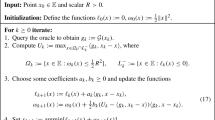Abstract
A variant of the ellipsoid method for nonlinear programming is introduced to enhance the speed of convergence. This variant is based on a new simple scheme to reduce the ellipsoid volume by using two center cuts generated in two consecutive iterations of the ellipsoid method. Computational tests show a significant improvement in computational efficiency. The tests show that the improvement is more significant for larger-size problems.
Similar content being viewed by others
References
Shor, N. Z.,Cut-Off Method with Space Extension in Convex Programming Problems, Cybernetics, Vol. 12, pp. 94–96, 1977.
Iudin, D. B., andNemirovskii, A. S.,Informational Complexity and Effective Methods for Solving Convex Extremal Problems, Matekon, Vol. 13, pp. 25–45, 1977.
Ecker, J. G., andKupferschmid, M.,A Computational Comparison of the Ellipsoid Algorithm with Several Nonlinear Programming Algorithms, SIAM Journal on Control and Optimization, Vol. 23, pp. 657–674, 1985.
Ecker, J. G., andKupferschmid, M.,An Ellipsoid Algorithm for Nonlinear Programming, Mathematical Programming, Vol. 27, pp. 83–106, 1983.
Shor, N. Z., andZhurbenko, N. G.,A Minimization Method Using the Operation of Extension of the Space in the Direction of the Difference of Two Successive Gradients, Cybernetics, Vol. 7, pp. 450–459, 1972.
Shor, N. Z.,Minimization Methods for Nondifferentiable Functions, Springer Verlag, Berlin, Germany, 1985.
Dziuban, S. T., Ecker, J. G., andKupferschmid, M.,Using Deep Cuts in an Ellipsoid Algorithm for Nonlinear Programming, Mathematical Programming Study, Vol. 25, pp. 93–107, 1985.
Ech-Cherif, A., Ecker, J. G., andKupferschmid, M.,A Numerical Investigation of Rank-Two Ellipsoid Algorithms for Nonlinear Programming, Mathematical Programming, Vol. 43, pp. 87–95, 1989.
Shor, N. Z., andGershovich, V. I.,Family of Algorithms for Solving Convex Programming Problems, Cybernetics, Vol. 15, pp. 502–508, 1980.
Bland, R. G., Goldfarb, D., andTodd, M. J.,The Ellipsoid Method: A Survey, Operations Research, Vol. 29, pp. 1039–1091, 1981.
Todd, M. J.,On Minimum Volume Ellipsoids Containing Part of a Given Ellipsoid, Mathematics of Operations Research, Vol. 7, pp. 253–261, 1982.
Ech-Cherif, A., andEcker, J. G.,A Class of Rank-Two Ellipsoid Algorithms for Convex Programming, Mathematical Programming, Vol. 29, pp. 187–202, 1984.
Avriel, M.,Nonlinear Programming: Analysis and Methods, Prentice-Hall, Englewood Cliffs, New Jersey, 1976.
Luthi, H. J.,On the Solution of Variational Inequalities by the Ellipsoid Method, Mathematics of Operations Research, Vol. 10, pp. 515–522, 1985.
Author information
Authors and Affiliations
Additional information
Communicated by D. G. Luenberger
Rights and permissions
About this article
Cite this article
Kim, S., Kim, D. & Chang, K.N. Using two successive subgradients in the ellipsoid method for nonlinear programming. J Optim Theory Appl 82, 543–554 (1994). https://doi.org/10.1007/BF02192217
Issue Date:
DOI: https://doi.org/10.1007/BF02192217



